Hong Xu
The Multi-Query Paradox in Zeroth-Order Optimization
Sep 19, 2025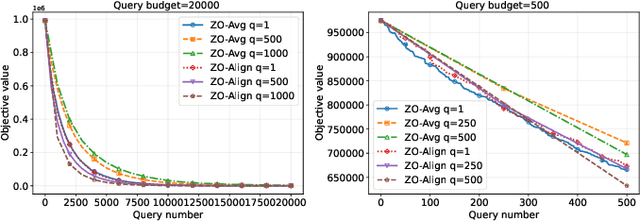
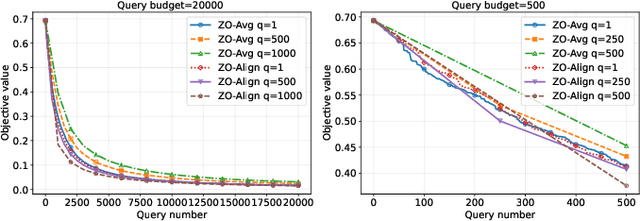
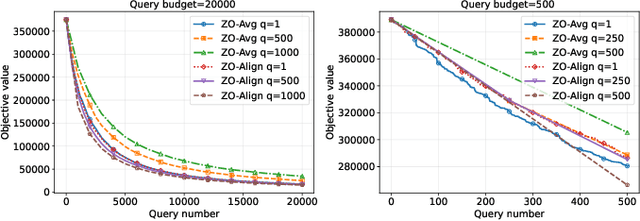
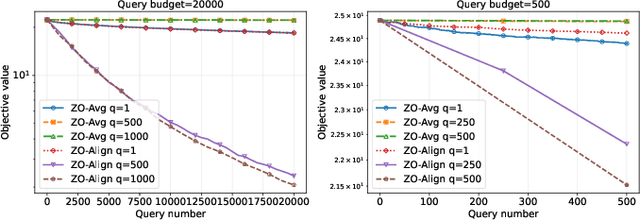
Abstract:Zeroth-order (ZO) optimization provides a powerful framework for problems where explicit gradients are unavailable and have to be approximated using only queries to function value. The prevalent single-query approach is simple, but suffers from high estimation variance, motivating a multi-query paradigm to improves estimation accuracy. This, however, creates a critical trade-off: under a fixed budget of queries (i.e. cost), queries per iteration and the total number of optimization iterations are inversely proportional to one another. How to best allocate this budget is a fundamental, under-explored question. This work systematically resolves this query allocation problem. We analyze two aggregation methods: the de facto simple averaging (ZO-Avg), and a new Projection Alignment method (ZO-Align) we derive from local surrogate minimization. By deriving convergence rates for both methods that make the dependence on the number of queries explicit across strongly convex, convex, non-convex, and stochastic settings, we uncover a stark dichotomy: For ZO-Avg, we prove that using more than one query per iteration is always query-inefficient, rendering the single-query approach optimal. On the contrary, ZO-Align generally performs better with more queries per iteration, resulting in a full-subspace estimation as the optimal approach. Thus, our work clarifies that the multi-query problem boils down to a choice not about an intermediate query size, but between two classic algorithms, a choice dictated entirely by the aggregation method used. These theoretical findings are also consistently validated by extensive experiments.
Multimodal Learning for Fake News Detection in Short Videos Using Linguistically Verified Data and Heterogeneous Modality Fusion
Sep 19, 2025Abstract:The rapid proliferation of short video platforms has necessitated advanced methods for detecting fake news. This need arises from the widespread influence and ease of sharing misinformation, which can lead to significant societal harm. Current methods often struggle with the dynamic and multimodal nature of short video content. This paper presents HFN, Heterogeneous Fusion Net, a novel multimodal framework that integrates video, audio, and text data to evaluate the authenticity of short video content. HFN introduces a Decision Network that dynamically adjusts modality weights during inference and a Weighted Multi-Modal Feature Fusion module to ensure robust performance even with incomplete data. Additionally, we contribute a comprehensive dataset VESV (VEracity on Short Videos) specifically designed for short video fake news detection. Experiments conducted on the FakeTT and newly collected VESV datasets demonstrate improvements of 2.71% and 4.14% in Marco F1 over state-of-the-art methods. This work establishes a robust solution capable of effectively identifying fake news in the complex landscape of short video platforms, paving the way for more reliable and comprehensive approaches in combating misinformation.
Automating Conflict-Aware ACL Configurations with Natural Language Intents
Aug 25, 2025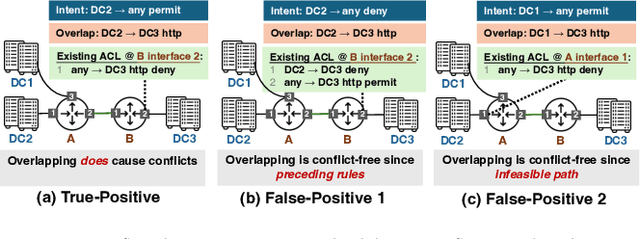

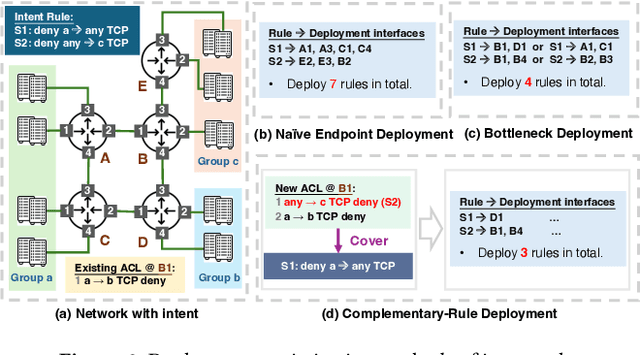

Abstract:ACL configuration is essential for managing network flow reachability, yet its complexity grows significantly with topologies and pre-existing rules. To carry out ACL configuration, the operator needs to (1) understand the new configuration policies or intents and translate them into concrete ACL rules, (2) check and resolve any conflicts between the new and existing rules, and (3) deploy them across the network. Existing systems rely heavily on manual efforts for these tasks, especially for the first two, which are tedious, error-prone, and impractical to scale. We propose Xumi to tackle this problem. Leveraging LLMs with domain knowledge of the target network, Xumi automatically and accurately translates the natural language intents into complete ACL rules to reduce operators' manual efforts. Xumi then detects all potential conflicts between new and existing rules and generates resolved intents for deployment with operators' guidance, and finally identifies the best deployment plan that minimizes the rule additions while satisfying all intents. Evaluation shows that Xumi accelerates the entire configuration pipeline by over 10x compared to current practices, addresses O(100) conflicting ACLs and reduces rule additions by ~40% in modern cloud network.
Adaptive Particle-Based Shape Modeling for Anatomical Surface Correspondence
Jul 10, 2025Abstract:Particle-based shape modeling (PSM) is a family of approaches that automatically quantifies shape variability across anatomical cohorts by positioning particles (pseudo landmarks) on shape surfaces in a consistent configuration. Recent advances incorporate implicit radial basis function representations as self-supervised signals to better capture the complex geometric properties of anatomical structures. However, these methods still lack self-adaptivity -- that is, the ability to automatically adjust particle configurations to local geometric features of each surface, which is essential for accurately representing complex anatomical variability. This paper introduces two mechanisms to increase surface adaptivity while maintaining consistent particle configurations: (1) a novel neighborhood correspondence loss to enable high adaptivity and (2) a geodesic correspondence algorithm that regularizes optimization to enforce geodesic neighborhood consistency. We evaluate the efficacy and scalability of our approach on challenging datasets, providing a detailed analysis of the adaptivity-correspondence trade-off and benchmarking against existing methods on surface representation accuracy and correspondence metrics.
DynamicBench: Evaluating Real-Time Report Generation in Large Language Models
Jun 26, 2025Abstract:Traditional benchmarks for large language models (LLMs) typically rely on static evaluations through storytelling or opinion expression, which fail to capture the dynamic requirements of real-time information processing in contemporary applications. To address this limitation, we present DynamicBench, a benchmark designed to evaluate the proficiency of LLMs in storing and processing up-to-the-minute data. DynamicBench utilizes a dual-path retrieval pipeline, integrating web searches with local report databases. It necessitates domain-specific knowledge, ensuring accurate responses report generation within specialized fields. By evaluating models in scenarios that either provide or withhold external documents, DynamicBench effectively measures their capability to independently process recent information or leverage contextual enhancements. Additionally, we introduce an advanced report generation system adept at managing dynamic information synthesis. Our experimental results confirm the efficacy of our approach, with our method achieving state-of-the-art performance, surpassing GPT4o in document-free and document-assisted scenarios by 7.0% and 5.8%, respectively. The code and data will be made publicly available.
Towards Robust Learning to Optimize with Theoretical Guarantees
Jun 17, 2025Abstract:Learning to optimize (L2O) is an emerging technique to solve mathematical optimization problems with learning-based methods. Although with great success in many real-world scenarios such as wireless communications, computer networks, and electronic design, existing L2O works lack theoretical demonstration of their performance and robustness in out-of-distribution (OOD) scenarios. We address this gap by providing comprehensive proofs. First, we prove a sufficient condition for a robust L2O model with homogeneous convergence rates over all In-Distribution (InD) instances. We assume an L2O model achieves robustness for an InD scenario. Based on our proposed methodology of aligning OOD problems to InD problems, we also demonstrate that the L2O model's convergence rate in OOD scenarios will deteriorate by an equation of the L2O model's input features. Moreover, we propose an L2O model with a concise gradient-only feature construction and a novel gradient-based history modeling method. Numerical simulation demonstrates that our proposed model outperforms the state-of-the-art baseline in both InD and OOD scenarios and achieves up to 10 $\times$ convergence speedup. The code of our method can be found from https://github.com/NetX-lab/GoMathL2O-Official.
* Published in CVPR 2024, 55 pages, 17 figures, this version fixed some typo
Logits-Based Finetuning
May 30, 2025Abstract:The core of out-of-distribution (OOD) detection is to learn the in-distribution (ID) representation, which is distinguishable from OOD samples. Previous work applied recognition-based methods to learn the ID features, which tend to learn shortcuts instead of comprehensive representations. In this work, we find surprisingly that simply using reconstruction-based methods could boost the performance of OOD detection significantly. We deeply explore the main contributors of OOD detection and find that reconstruction-based pretext tasks have the potential to provide a generally applicable and efficacious prior, which benefits the model in learning intrinsic data distributions of the ID dataset. Specifically, we take Masked Image Modeling as a pretext task for our OOD detection framework (MOOD). Without bells and whistles, MOOD outperforms previous SOTA of one-class OOD detection by 5.7%, multi-class OOD detection by 3.0%, and near-distribution OOD detection by 2.1%. It even defeats the 10-shot-per-class outlier exposure OOD detection, although we do not include any OOD samples for our detection. Codes are available at https://github.com/JulietLJY/MOOD.
Easz: An Agile Transformer-based Image Compression Framework for Resource-constrained IoTs
May 03, 2025Abstract:Neural image compression, necessary in various machine-to-machine communication scenarios, suffers from its heavy encode-decode structures and inflexibility in switching between different compression levels. Consequently, it raises significant challenges in applying the neural image compression to edge devices that are developed for powerful servers with high computational and storage capacities. We take a step to solve the challenges by proposing a new transformer-based edge-compute-free image coding framework called Easz. Easz shifts the computational overhead to the server, and hence avoids the heavy encoding and model switching overhead on the edge. Easz utilizes a patch-erase algorithm to selectively remove image contents using a conditional uniform-based sampler. The erased pixels are reconstructed on the receiver side through a transformer-based framework. To further reduce the computational overhead on the receiver, we then introduce a lightweight transformer-based reconstruction structure to reduce the reconstruction load on the receiver side. Extensive evaluations conducted on a real-world testbed demonstrate multiple advantages of Easz over existing compression approaches, in terms of adaptability to different compression levels, computational efficiency, and image reconstruction quality.
DSV: Exploiting Dynamic Sparsity to Accelerate Large-Scale Video DiT Training
Feb 11, 2025Abstract:Diffusion Transformers (DiTs) have shown remarkable performance in modeling and generating high-quality videos. However, the quadratic computational complexity of 3D full attention mechanism presents significant challenges in scaling video DiT training, especially for high-definition and lengthy videos, where attention can dominate up to 95% of the end-to-end time and necessitate specialized communication paradigms to handle large input sizes. This paper introduces DSV, a novel framework designed to accelerate and scale the training of video DiTs by leveraging the inherent dynamic attention sparsity throughout the training process. DSV employs a two-stage training algorithm that exploits sparsity patterns, focusing on critical elements supported by efficient, tailored kernels. To accommodate the new sparsity dimension, we develop a hybrid sparsity-aware context parallelism that effectively scales to large inputs by addressing the heterogeneity of sparsity across attention heads and blocks, resulting in optimized sparse computation and communication. Extensive evaluations demonstrate that DSV achieves up to 3.02x gain in training throughput with nearly no quality degradation.
Learning Provablely Improves the Convergence of Gradient Descent
Jan 30, 2025



Abstract:As a specialized branch of deep learning, Learning to Optimize (L2O) tackles optimization problems by training DNN-based solvers. Despite achieving significant success in various scenarios, such as faster convergence in solving convex optimizations and improved optimality in addressing non-convex cases, there remains a deficiency in theoretical support. Current research heavily relies on stringent assumptions that do not align with the intricacies of the training process. To address this gap, our study aims to establish L2O's convergence through its training methodology. We demonstrate that learning an algorithm's hyperparameters significantly enhances its convergence. Focusing on the gradient descent (GD) algorithm for quadratic programming, we prove the convergence of L2O's training using the neural tangent kernel theory. Moreover, we conduct empirical evaluations using synthetic datasets. Our findings indicate exceeding 50\% outperformance over the GD methods.
 Add to Chrome
Add to Chrome Add to Firefox
Add to Firefox Add to Edge
Add to Edge